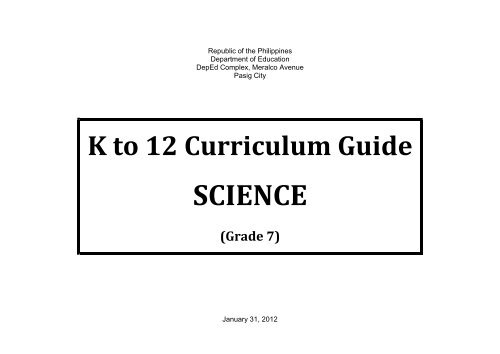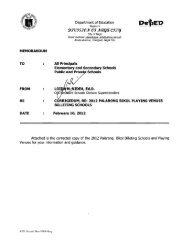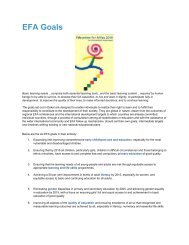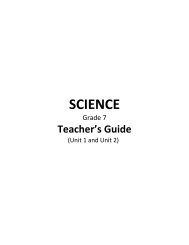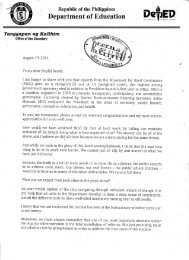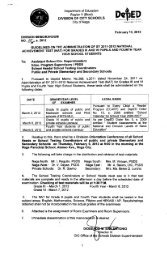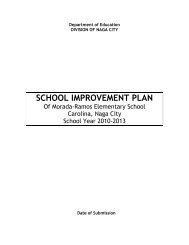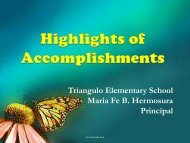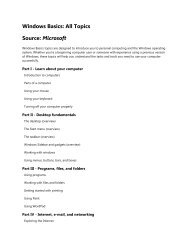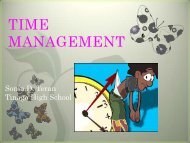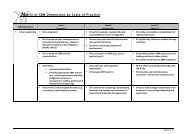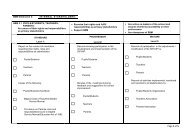K to 12 Curriculum Guide SCIENCE - DepEd Naga City
K to 12 Curriculum Guide SCIENCE - DepEd Naga City
K to 12 Curriculum Guide SCIENCE - DepEd Naga City
Create successful ePaper yourself
Turn your PDF publications into a flip-book with our unique Google optimized e-Paper software.
Republic of the Philippines<br />
Department of Education<br />
<strong>DepEd</strong> Complex, Meralco Avenue<br />
Pasig <strong>City</strong><br />
K <strong>to</strong> <strong>12</strong> <strong>Curriculum</strong> <strong>Guide</strong><br />
<strong>SCIENCE</strong><br />
(Grade 7)<br />
January 31, 20<strong>12</strong>
K TO <strong>12</strong> <strong>SCIENCE</strong><br />
CONCEPTUAL FRAMEWORK<br />
Science education aims <strong>to</strong> develop scientific literacy among students that will prepare them <strong>to</strong> be informed and participative citizens who are able <strong>to</strong><br />
make judgments and decisions regarding applications of scientific knowledge that may have social, health, or environmental impacts.<br />
The science curriculum recognizes the place of science and technology in everyday human affairs. It integrates science and technology in the civic,<br />
personal, social, economic, and the values and ethical aspects of life. The science curriculum promotes a strong link between science and technology,<br />
including indigenous technology, keeping our country’s cultural uniqueness and peculiarities intact.<br />
Whether or not students pursue careers that involve science and technology, the K <strong>to</strong> <strong>12</strong> science curriculum will provide students with a reper<strong>to</strong>ire of<br />
competencies important in the world of work and in a knowledge-based society. The K <strong>to</strong> <strong>12</strong> science curriculum envisions the development of scientifically,<br />
technologically, and environmentally literate and productive members of society who manifest skills as a critical problem solvers, responsible stewards of<br />
nature, innovative and creative citizens, informed decision makers, and effective communica<strong>to</strong>rs. This curriculum is designed around the three domains of<br />
learning science: understanding and applying scientific knowledge in local setting as well as global, context whenever possible, performing scientific<br />
processes and skills, and developing and demonstrating scientific attitudes and values. The acquisition of these domains is facilitated using the following<br />
approaches: multi/interdisciplinary approach, science–technology society approach, contextual learning, problem/issue-based learning, and inquiry-based<br />
approach. The approaches are based on sound educational pedagogy namely: constructivism, social cognition learning model, learning style theory, and<br />
Gestalt psychology.<br />
Science content and science processes are intertwined in the K <strong>to</strong> <strong>12</strong> curriculum. Without the content, learners will have difficulty utilizing science<br />
process skills since these processes are best learned in context. Organizing the curriculum around situations and problems that challenge and arouse<br />
students’ curiosity motivates them <strong>to</strong> learn and appreciate science as relevant and useful. Rather than relying solely on textbooks, varied hands-on, minds-on,<br />
and hearts-on activities will be used <strong>to</strong> develop students’ interest and let them become active learners.<br />
As a whole, the K <strong>to</strong> <strong>12</strong> science curriculum is learner-centered and inquiry-based, emphasizing the use of evidence in constructing explanations.<br />
Concepts and skills in Life Sciences, Physics, Chemistry, and Earth Sciences are presented with increasing levels of complexity from one grade level <strong>to</strong><br />
another (spiral progression), thus paving the way <strong>to</strong> deeper understanding of a few concepts. These concepts and skills are integrated rather than disciplinebased,<br />
stressing the connections across science <strong>to</strong>pics and other disciplines as well as applications of concepts and thinking skills <strong>to</strong> real life.<br />
K <strong>to</strong> <strong>12</strong> <strong>Curriculum</strong> <strong>Guide</strong> Science – version as of January 31, 20<strong>12</strong> 2
K TO <strong>12</strong> <strong>SCIENCE</strong><br />
Developing and<br />
Demonstrating Scientific<br />
Attitudes and Values<br />
The Conceptual Framework of Science Education<br />
K <strong>to</strong> <strong>12</strong> <strong>Curriculum</strong> <strong>Guide</strong> Science – version as of January 31, 20<strong>12</strong> 3
K TO <strong>12</strong> <strong>SCIENCE</strong><br />
CORE LEARNING AREA STANDARD: (<strong>SCIENCE</strong> FOR THE ENTIRE K TO <strong>12</strong>)<br />
The learner demonstrates understanding of basic science concepts, applies science process skills, and exhibits scientific attitudes and values <strong>to</strong><br />
solve problems critically, innovate beneficial products, protect the environment and conserve resources, enhance the integrity and wellness of people,<br />
and make informed and unbiased decisions about social issues that involve science and technology. This understanding will lead <strong>to</strong> learner’s<br />
manifestation of respect for life and the environment, bearing in mind that Earth is our ONLY HOME.<br />
KEY STAGE STANDARDS: (STANDARD FOR <strong>SCIENCE</strong> LEARNING AREA FOR K-3, 4-6, 7-10 AND 11-<strong>12</strong>)<br />
K – 3 4 – 6 7 – 10 11-<strong>12</strong><br />
At the end of Grade 3, the<br />
learners should have<br />
acquired healthful habits<br />
and developed curiosity<br />
about self and their<br />
environment using basic<br />
process skills of observing,<br />
communicating, comparing,<br />
classifying, measuring,<br />
inferring and predicting.<br />
This curiosity will help<br />
learners value science as<br />
an important <strong>to</strong>ol in helping<br />
them continue <strong>to</strong> explore<br />
their natural and physical<br />
environment.<br />
At the end of Grade 6, the learners<br />
should have developed the essential<br />
skills of scientific inquiry – designing<br />
simple investigations, using<br />
appropriate procedure, materials<br />
and <strong>to</strong>ols <strong>to</strong> gather evidence,<br />
observing patterns, determining<br />
relationships,drawing conclusions<br />
based on evidence, and<br />
communicating ideas in varied ways<br />
<strong>to</strong> make meaning of the<br />
observations and/or changes that<br />
occur in the environment. The<br />
content and skills learned will be<br />
applied <strong>to</strong> maintain good health,<br />
ensure the protection and<br />
improvement of the environment,<br />
and practice safety measures.<br />
At the end of Grade 10, the learner<br />
should have developed scientific,<br />
technological and environmental literacy<br />
so that they will not be isolated from the<br />
society where they live, will not be<br />
overwhelmed by change, and can make<br />
rational choices on issues confronting<br />
them. Having been exposed <strong>to</strong> scientific<br />
investigations related <strong>to</strong> real-life, they<br />
should recognize that the central feature<br />
of an investigation is that if one variable is<br />
changed (while controlling all others), the<br />
effect of the change on another variable is<br />
measured. The context of the<br />
investigation can be problems at the local<br />
or national level <strong>to</strong> allow them <strong>to</strong><br />
communicate with students in other parts<br />
of the Philippines or even from other<br />
countries using appropriate technology.<br />
At the end of Grade <strong>12</strong>, the learner<br />
should have gained skills in<br />
obtaining scientific and<br />
technological information from<br />
varied sources about global issues<br />
that have impact on the country.<br />
They should have acquired<br />
attitudes that will allow them <strong>to</strong><br />
innovate and/or create products<br />
useful <strong>to</strong> the community or country.<br />
They should be able <strong>to</strong> process<br />
information <strong>to</strong> get relevant data for<br />
a problem at hand. In addition,<br />
learners should have made plans<br />
related <strong>to</strong> their interests and<br />
expertise, considering the needs<br />
of their community and the country<br />
— <strong>to</strong> pursue either employment,<br />
entrepreneurship, or higher<br />
education.<br />
K <strong>to</strong> <strong>12</strong> <strong>Curriculum</strong> <strong>Guide</strong> Science – version as of January 31, 20<strong>12</strong> 4
K TO <strong>12</strong> <strong>SCIENCE</strong><br />
Grade/Level<br />
K<br />
Grade 1<br />
Grade 2<br />
Grade 3<br />
Grade Level Standards<br />
Concepts and skills in the kindergarten curriculum are taught thematically so that it is difficult <strong>to</strong> identify specific science ideas.<br />
At the end of Grade 1, learners will use their senses <strong>to</strong> locate and describe the parts of their body and tell the shape, color, texture, taste,<br />
and size of things around them. They will differentiate sounds produced by animals, vehicles cars, and musical instruments. They will<br />
illustrate how things move. They will describe similarities and differences, given two things. They will use appropriate terms or vocabulary<br />
<strong>to</strong> describe these features. They will collect, sort, count, draw, take things apart, or make something out of the things. They will practice<br />
health habits (e.g., washing hands properly, choosing nutritious food) and help clean or pack away their <strong>to</strong>ys. They will ask questions.<br />
They will give simple answer/ descriptions <strong>to</strong> probing questions.<br />
At the end of Grade 2, learners will use their senses <strong>to</strong> describe more than two objects and using more than two properties. They can<br />
sort things in different ways and give a reason for doing so. They will describe the kind of weather or certain events in the home or school<br />
and express how these are affecting them. They will tell why some things around them are important. They will decide if what they do is<br />
safe or dangerous. They will give suggestions on how <strong>to</strong> prevent accidents at home (not playing with matches or sharp objects). They will<br />
switch off light when not in use or conserve water when taking a bath or brushing teeth. They will help take care of pets or of plants. They<br />
will tell short s<strong>to</strong>ries about what they do, what they have seen, or what they feel.<br />
At the end of Grade 3, learners will describe the functions of the different parts of the body and things that make up their surroundings ---<br />
rocks and soil, plants and animals, the Sun, Moon and stars. They will also learn that things may be solid, liquid or gas while others may<br />
give off light, heat and sound. They will also observe changes in the conditions of their surroundings. These will lead learners <strong>to</strong> become<br />
more curious about their surroundings, appreciate nature, and practice health and safety measures.<br />
After investigating, learners will identify materials that do not decay and use this knowledge <strong>to</strong> help minimize waste at home, school, and<br />
in the community. They will also investigate changes in the properties of materials when these are subjected <strong>to</strong> different conditions.<br />
Grade 4<br />
The learners will describe the internal parts of the body and their functions in order <strong>to</strong> practice ways <strong>to</strong> maintain good health. They will<br />
classify plants and animals according <strong>to</strong> where they live and observe interactions among living things and their environment. They will infer<br />
that plants and animals have traits that help them survive in their environment.<br />
Learners will investigate which type of soil is best for certain plants and infer the importance of water in daily activities. They will learn<br />
about what makes up weather and apply their knowledge of weather conditions in making decisions for the day. Learners will also infer the<br />
importance of the Sun <strong>to</strong> life on Earth.<br />
Learners will investigate the effects of push or pull on the size, shape, and movement of an object<br />
K <strong>to</strong> <strong>12</strong> <strong>Curriculum</strong> <strong>Guide</strong> Science – version as of January 31, 20<strong>12</strong> 5
K TO <strong>12</strong> <strong>SCIENCE</strong><br />
Grade/Level<br />
Grade 5<br />
Grade Level Standards<br />
After investigating, learners will decide whether materials are safe and useful based on their properties. They will also infer that new<br />
materials may form when there are changes in properties.<br />
Learners will develop healthful and hygienic practices related <strong>to</strong> the reproductive system after describing changes that accompany<br />
puberty. They will compare different modes of reproduction among plant and animal groups and conduct an investigation on pollination.<br />
They will also make decisions about the preservation of estuaries and intertidal zones.<br />
Learners will recognize that different materials react differently with heat, light, and sound. They will relate these abilities of materials <strong>to</strong><br />
their specific uses.<br />
Learners will describe the changes that earth materials undergo. They will learn about the effects of typhoons and make emergency plans<br />
with their families in preparation for typhoons. They will also observe patterns in the natural events by observing the appearance of the<br />
Moon<br />
Learners will understand how the different organ systems work <strong>to</strong>gether. They will classify plants based on reproductive structures and<br />
animals based on the presence or lack of backbone. They will design and conduct an investigation on plant propagation. They will also<br />
learn about larger ecosystems such as rainforests, coral reefs, and mangrove swamps.<br />
Grade 6<br />
Learners will recognize that when mixed <strong>to</strong>gether, materials do not form new ones thus these materials may be recovered using different<br />
separation techniques. Learners will also prepare useful mixtures such as food, drinks and herbal medicines.<br />
Learners will describe what happens during earthquakes and volcanic eruptions and demonstrate what <strong>to</strong> do when they occur. They will<br />
infer that the weather follows a pattern in the course of a year. They will learn about the solar system, with emphasis on the motions of the<br />
Earth as prerequisite <strong>to</strong> the study of seasons in another grade level.<br />
Learners will infer that friction and gravity affect how people and objects move. They will also discover that heat, light, sound, electricity,<br />
and motion studied earlier are forms of energy and these undergo transformation.<br />
Learners will recognize the system of classification of matter through semi-guided investigations but emphasizing fair testing.<br />
Grade 7<br />
Learners will describe what makes up the Philippines as a whole and the resources found in the archipelago. They will explain the<br />
occurrence of breezes, monsoons, and ITCZ and how these weather systems affect people. Using concepts in the previous grade,<br />
learners will demonstrate why the seasons change and how eclipses occur.<br />
Learners will describe the motion of objects in terms of distance and speed and represent this in tables, graphs, charts, and equations.<br />
K <strong>to</strong> <strong>12</strong> <strong>Curriculum</strong> <strong>Guide</strong> Science – version as of January 31, 20<strong>12</strong> 6
K TO <strong>12</strong> <strong>SCIENCE</strong><br />
Grade/Level<br />
Grade Level Standards<br />
They will also investigate how various forms of energy travel through different media.<br />
After studying how organ systems work <strong>to</strong>gether in plants and animals in the lower grades, learners will now observe very small organisms<br />
and structures using a microscope. They will understand that living things are organized in<strong>to</strong> different levels: cells, tissues, organs, organ<br />
systems, and organisms. These organisms comprise populations and communities which interact with nonliving things in ecosystems.<br />
Learners will now recognize reproduction as a process of cell division resulting in growth of organisms. They will also deal deeper in<strong>to</strong> the<br />
process of digestion studied in the lower grades giving emphasis on proper nutrition for overall wellness. This will lead them <strong>to</strong> participate<br />
in activities that will protect and conserve economically important species used for food.<br />
Grade 8<br />
Learners will explain the behavior of matter in terms of the particles it is made of. They will also recognize that ingredients in food and<br />
medical products are made up of these particles and are absorbed by the body in the form of ions.<br />
Learners will explain how active faults generate earthquakes and how tropical cyclones originate from warm ocean waters. They will also<br />
learn about the other members of the solar system.<br />
Learners will investigate the effects of some fac<strong>to</strong>rs on the motion of an object based on the Laws of Motion. They will also differentiate<br />
the concept of work as used in science and in layman’s language. They will also learn about fac<strong>to</strong>rs that affect the transfer of energy such<br />
as the molecular structure of the medium and temperature difference.<br />
After learning about the digestive system, learners will now expand their knowledge <strong>to</strong> a deeper understanding of the respira<strong>to</strong>ry and<br />
circula<strong>to</strong>ry systems <strong>to</strong> promote overall health. They will also learn about some technologies that will introduce desired traits in<br />
economically important plants and animals.<br />
Grade 9<br />
Learners will explain how new materials are formed when a<strong>to</strong>ms are rearranged. They will also recognize that a wide variety of useful<br />
compounds may arise from such rearrangements.<br />
Learners will identify volcanoes in the community or region and distinguish between active and inactive ones. They will also explain how<br />
energy from volcanoes may be tapped for human use. Learners will also learn about climatic phenomena that occur on a global scale.<br />
They will also explain why certain constellations can be seen only at certain times of the year.<br />
Learners will predict the outcomes of interactions among objects in real life applying the laws of conservation of energy and momentum.<br />
K <strong>to</strong> <strong>12</strong> <strong>Curriculum</strong> <strong>Guide</strong> Science – version as of January 31, 20<strong>12</strong> 7
K TO <strong>12</strong> <strong>SCIENCE</strong><br />
Grade/Level<br />
Grade 10<br />
Grade Level Standards<br />
Learners will now complete the study of the entire organism with their deeper study of the excre<strong>to</strong>ry and reproductive systems. They will<br />
also explain in greater detail how genetic information is passed from parents <strong>to</strong> offspring and how diversity of species increases the<br />
probability of adaptation and survival in changing environments.<br />
Learners will recognize the importance of controlling the conditions under which a phenomenon or reaction occurs. They will also<br />
recognize that cells and tissues of the human body are made up of water, a few kinds of ions, and biomolecules. These biomolecules may<br />
also be found in the food they eat.<br />
Learners will show that volcanoes and earthquakes occur in the same places in the world and that these are related <strong>to</strong> plate boundaries.<br />
Learners will also demonstrate ways <strong>to</strong> ensure safety and reduce damage during earthquakes, tsunamis, and volcanic eruptions.<br />
Learners will investigate fac<strong>to</strong>rs that affect the balance and stability of an object <strong>to</strong> enable them <strong>to</strong> practice appropriate positions and<br />
movements <strong>to</strong> achieve efficiency and safety such as in sports and dancing. They will also analyze situations where energy is harnessed<br />
for human use whereby heat is released affecting the physical and biological components of the environment.<br />
Grade 11<br />
Grade <strong>12</strong><br />
To be completed after the meeting with G11-<strong>12</strong> TWG<br />
To be completed after the meeting with G11-<strong>12</strong> TWG<br />
K <strong>to</strong> <strong>12</strong> <strong>Curriculum</strong> <strong>Guide</strong> Science – version as of January 31, 20<strong>12</strong> 8
K TO <strong>12</strong> <strong>SCIENCE</strong><br />
GRADE 7<br />
GRADE 7 - Matter<br />
FIRST QUARTER/FIRST GRADING PERIOD<br />
Content Content Standards Performance Standards Learning Competencies<br />
The Investiga<strong>to</strong>ry Process<br />
The learner…<br />
The learner…<br />
The learner…<br />
<br />
Ways of acquiring<br />
knowledge and solving<br />
problems<br />
<br />
demonstrates understanding of<br />
scientific way of acquiring<br />
knowledge and solving problems<br />
<br />
conducts simple investigations using<br />
the inquiry approach<br />
<br />
<br />
describes what is meant by fair test.<br />
recognizes that the design of an<br />
investigation should show fair testing.<br />
<br />
identifies the components of an<br />
investigation: research problem,<br />
hypothesis, method for testing hypothesis<br />
(identifying independent/dependent<br />
variables), and conclusions based on<br />
evidence<br />
<br />
conducts simple investigations using<br />
processes involving mixtures common <strong>to</strong><br />
the locality.<br />
<br />
chooses an interesting <strong>to</strong>pic for<br />
investigation.<br />
- formulates a research problem.<br />
- formulates a hypothesis.<br />
- designs a procedure <strong>to</strong> test the<br />
hypothesis.<br />
- collects, organizes and interprets data.<br />
- makes conclusions based on the data,<br />
accounting and rejecting the<br />
hypothesis.<br />
- writes a brief summary of the report.<br />
- shares and presents the results of the<br />
investigations with other classmates or<br />
schoolmates.<br />
K <strong>to</strong> <strong>12</strong> <strong>Curriculum</strong> <strong>Guide</strong> Science – version as of January 31, 20<strong>12</strong> 9
K TO <strong>12</strong> <strong>SCIENCE</strong><br />
Content Content Standards Performance Standards Learning Competencies<br />
Diversity of Materials in<br />
the Environment<br />
<br />
Solutions<br />
The learner…<br />
<br />
demonstrates understanding of<br />
solutions such as acids and<br />
bases and ways of describing<br />
their concentration.<br />
The learner…<br />
<br />
prepares different concentrations of<br />
mixtures considering the following:<br />
- has practical uses<br />
- prepared within the best possible<br />
period of time<br />
- easily available materials<br />
- with right composition and<br />
proportion of components.<br />
The learner…<br />
<br />
<br />
investigates the different types of<br />
solutions.<br />
- unsaturated<br />
- saturated<br />
- supersaturated<br />
explains the difference between<br />
Percentage by Weight and by Volume<br />
solutions.<br />
<br />
identifies and explains the fac<strong>to</strong>rs<br />
affecting solubility.<br />
<br />
Acids and Bases<br />
<br />
<br />
interprets properly product labels of<br />
common acids and bases for safety<br />
and cost benefits.<br />
practices safe ways of handling<br />
acids and bases by using protective<br />
clothing and safety gears.<br />
<br />
<br />
<br />
recognizes common acids and bases<br />
.<br />
recognizes the concept of pH.<br />
investigates properties of acids and<br />
bases using natural indica<strong>to</strong>rs such as<br />
eggplant skin, mayana leaves or violetcolored<br />
camote leaves.<br />
<br />
investigates action of acids on metals and<br />
building materials.<br />
<br />
investigates action of bases on materials.<br />
<br />
practices safe handling of acids and<br />
bases.<br />
<br />
investigates neutralization of acids and<br />
bases.<br />
K <strong>to</strong> <strong>12</strong> <strong>Curriculum</strong> <strong>Guide</strong> Science – version as of January 31, 20<strong>12</strong> 10
Content<br />
Substances and.<br />
Mixtures<br />
Elements and<br />
Compounds<br />
Metals and<br />
Nonmetals<br />
The learner…<br />
<br />
<br />
K TO <strong>12</strong> <strong>SCIENCE</strong><br />
Content Standards Performance Standards Learning Competencies<br />
demonstrates understanding of<br />
the properties of substances<br />
which distinguish them from<br />
mixtures.<br />
demonstrates understanding of<br />
classifying substances as<br />
elements or compounds and<br />
distinguishes between metals<br />
and nonmetals.<br />
GRADE 7 - Living Things and Their Environment<br />
SECOND QUARTER/SECOND GRADING PERIOD<br />
Parts and Functions<br />
The learner…<br />
<br />
chooses appropriate materials<br />
available in the community for<br />
specific purposes.<br />
The learner…<br />
<br />
<br />
<br />
<br />
<br />
<br />
<br />
recognizes that a substance has a unique<br />
set of properties.<br />
investigates the properties of mixtures of<br />
varying concentrations.<br />
recognizes that substances are classified<br />
in<strong>to</strong> elements and compounds.<br />
recognizes that compounds consist of<br />
specific elements<br />
gather information about common<br />
elements such as names, symbols and<br />
whether it is a metal or nonmetal from a<br />
Periodic Table<br />
demonstrates the different properties of<br />
metals and nonmetals such as luster,<br />
malleability, ductility, and conductivity.<br />
recognizes the elements considered as<br />
metals and those that are nonmetals.<br />
<br />
<br />
<br />
<br />
Levels of organization<br />
Microscopy<br />
Animal and plant cells<br />
Microorganisms:<br />
Fungi, Protists, and<br />
Bacteria<br />
<br />
<br />
demonstrates understanding of<br />
the different levels of<br />
organization<br />
demonstrates understanding<br />
that aside from plants and<br />
animals, there are other much<br />
smaller organisms that can only<br />
be seen through the<br />
microscope; many of which<br />
consist of only one cell<br />
<br />
<br />
employs appropriate techniques<br />
using standard <strong>to</strong>ols or equipment <strong>to</strong><br />
gather data about very small objects<br />
recognizes that many organisms,<br />
including humans, have organ<br />
systems that work <strong>to</strong>gether <strong>to</strong> carry<br />
out essential processes of the body<br />
<br />
<br />
<br />
differentiates organ systems, organs,<br />
tissues, cells from each other<br />
identifies parts of the microscope and<br />
their functions<br />
differentiates plant and animal cells<br />
according <strong>to</strong> presence or absence of<br />
certain organelles<br />
K <strong>to</strong> <strong>12</strong> <strong>Curriculum</strong> <strong>Guide</strong> Science – version as of January 31, 20<strong>12</strong> 11
K TO <strong>12</strong> <strong>SCIENCE</strong><br />
Content Content Standards Performance Standards Learning Competencies<br />
Heredity: Inheritance and<br />
Variation<br />
Asexual reproduction<br />
in different organisms<br />
Sexual reproduction<br />
- Union of egg cell<br />
and sperm cell<br />
during fertilization<br />
- offspring are<br />
biologically similar<br />
<strong>to</strong> the parents but<br />
not identical<br />
Interactions<br />
<br />
<br />
Components of an<br />
ecosystem: biotic and<br />
abiotic<br />
Ecological<br />
relationships<br />
- Producers and<br />
consumers<br />
- Symbiotic<br />
relationships:<br />
parasitism,<br />
mutualism<br />
The learner…<br />
<br />
demonstrates understanding<br />
that reproduction can be asexual<br />
or sexual<br />
demonstrates understanding that<br />
organisms interact with each<br />
other and with their environment<br />
<strong>to</strong> survive<br />
The learner…<br />
<br />
<br />
<br />
<br />
engages in activities that promote<br />
proper nutrition and healthful habits<br />
<strong>to</strong> maintain proper functioning of the<br />
organ systems<br />
recognizes which organisms multiply<br />
on their own through asexual and<br />
sexual means<br />
decides on which means of asexual<br />
reproduction is appropriate <strong>to</strong> use in<br />
propagating economically important<br />
plants<br />
initiates and/or participates in<br />
activities that protect and preserve<br />
ecosystems in the locality<br />
The learner…<br />
K <strong>to</strong> <strong>12</strong> <strong>Curriculum</strong> <strong>Guide</strong> Science – version as of January 31, 20<strong>12</strong> <strong>12</strong><br />
<br />
<br />
<br />
<br />
<br />
<br />
<br />
<br />
<br />
<br />
<br />
describes the structures of<br />
microorganisms using a microscope<br />
identifies beneficial and harmful<br />
microorganisms<br />
explains why the cell is considered the<br />
basic structural and functional unit of all<br />
organisms<br />
compares asexual and sexual<br />
reproduction<br />
describes the process of fertilization<br />
differentiates offspring resulting from<br />
asexual reproduction with that from<br />
sexual reproduction in terms of<br />
similarities <strong>to</strong> parents<br />
identifies which of the things found in the<br />
environment are biotic or abiotic<br />
describes the different ecological<br />
relationships found in an ecosystem<br />
describes how energy is transformed<br />
through the feeding relationships<br />
predicts the effect of changes in one<br />
population on other populations in the<br />
ecosystem<br />
predicts the effect of changes in abiotic<br />
fac<strong>to</strong>rs on the ecosystem
K TO <strong>12</strong> <strong>SCIENCE</strong><br />
Content<br />
- non symbiotic<br />
relationships:<br />
competition,<br />
predation<br />
- transfer of energy<br />
through trophic<br />
levels<br />
Content Standards<br />
Performance Standards<br />
The learner… The learner... The learner…<br />
<br />
Learning Competencies<br />
explains the importance of individual and<br />
collective actions on protecting and<br />
preserving ecosystems<br />
GRADE 7- Force, Motion and Energy<br />
THIRD QUARTER/ THIRD GRADING PERIOD<br />
Constant and Uniformly<br />
Accelerated Motions<br />
<br />
Motion of objects in<br />
terms of<br />
displacement, speed<br />
or velocity, and<br />
acceleration<br />
demonstrates understanding of<br />
constant and uniformly<br />
accelerated motion in onedimension.<br />
advocates road safety. describes the motion of an object in terms<br />
of distance or displacement, speed or<br />
velocity, and acceleration.<br />
<br />
<br />
<br />
differentiates quantities (in terms of<br />
magnitude and direction) using the<br />
concepts of distance vs displacement and<br />
speed vs velocity<br />
creates and interprets visual<br />
representation of the motion of objects<br />
such as tape charts, motion graphs.<br />
solves problems involving constant and<br />
uniformly accelerated motion in onedimension<br />
using scalar quantities.<br />
<br />
enumerates some technologies that make<br />
use of motion detec<strong>to</strong>rs and<br />
explains/describes their applications.<br />
K <strong>to</strong> <strong>12</strong> <strong>Curriculum</strong> <strong>Guide</strong> Science – version as of January 31, 20<strong>12</strong> 13
K TO <strong>12</strong> <strong>SCIENCE</strong><br />
Content<br />
Content Standards<br />
Performance Standards<br />
Learning Competencies<br />
Motion Detec<strong>to</strong>rs The learner… The learner… The learner…<br />
<br />
innovates/enhances a simple <strong>to</strong>y car <strong>to</strong><br />
meet some standards through fair testing.<br />
Waves<br />
<br />
discusses various measures <strong>to</strong> improve<br />
road safety from the point of view of the<br />
physics involved.<br />
<br />
<br />
<br />
Transverse vs<br />
longitudinal Waves<br />
Mechanical vs<br />
electromagnetic<br />
waves<br />
Characteristics of<br />
waves<br />
<br />
demonstrates understanding of<br />
waves as a carriers of energy.<br />
<br />
<br />
<br />
infers that energy, like light and sound,<br />
travel in the form of waves.<br />
explains how waves carry energy from<br />
one place <strong>to</strong> another.<br />
distinguishes between transverse and<br />
longitudinal waves and mechanical and<br />
electromagnetic waves.<br />
<br />
creates a model <strong>to</strong> demonstrate the<br />
relationship among frequency, amplitude,<br />
wavelength, and wave velocity.<br />
Sound<br />
<br />
Characteristics of<br />
sound<br />
<br />
demonstrates understanding of<br />
the characteristics of sound such<br />
as pitch and loudness<br />
<br />
recognizes the use of indigenous<br />
materials in creating melodious<br />
music.<br />
<br />
uses the concepts of wavelength,<br />
velocity, and amplitude <strong>to</strong> describe<br />
characteristics of sound such as pitch,<br />
loudness and quality.<br />
<br />
demonstrates changes in pitch and<br />
loudness using real or improvised musical<br />
instrument through fair testing.<br />
<br />
explains sound production in the human<br />
voice box and how pitch, loudness and<br />
quality of sound vary from one person <strong>to</strong><br />
another.<br />
K <strong>to</strong> <strong>12</strong> <strong>Curriculum</strong> <strong>Guide</strong> Science – version as of January 31, 20<strong>12</strong> 14
K TO <strong>12</strong> <strong>SCIENCE</strong><br />
Content<br />
Content Standards<br />
Performance Standards<br />
Learning Competencies<br />
The learner… The learner… The learner…<br />
<br />
describes how organisms produce,<br />
transmit and receive sound of various<br />
frequencies (infrasonic, audible and<br />
ultrasonic sound).<br />
<br />
creates harmonious music using<br />
indigenous products.<br />
Light<br />
<br />
Characteristics of light:<br />
<br />
demonstrates understanding of<br />
the characteristics of light:<br />
intensity or brightness and color<br />
<br />
appreciates proper lighting in doing<br />
various activities.<br />
<br />
relates characteristics of light such as<br />
color and intensity <strong>to</strong> frequency and<br />
wavelength.<br />
<br />
designs and implements an experiment<br />
that shows that light travels in a straight<br />
line.<br />
<br />
investigates the relationship between light<br />
intensity and the distance from a light<br />
source through fair testing.<br />
Heat<br />
Heat transfer demonstrates understanding of<br />
the different modes of heat<br />
transfer: conduction, convection,<br />
radiation<br />
<br />
chooses right materials for a<br />
particular purpose for cooking, food<br />
s<strong>to</strong>rage, and building homes.<br />
<br />
<br />
infers the condition necessary for heat<br />
transfer <strong>to</strong> occur.<br />
conducts simple investigations <strong>to</strong><br />
demonstrate the different modes of heat<br />
transfer.<br />
<br />
explains different modes of heat transfer<br />
in the molecular level.<br />
<br />
identifies good and poor conduc<strong>to</strong>rs of<br />
heat and describe their specific uses<br />
K <strong>to</strong> <strong>12</strong> <strong>Curriculum</strong> <strong>Guide</strong> Science – version as of January 31, 20<strong>12</strong> 15
K TO <strong>12</strong> <strong>SCIENCE</strong><br />
Content<br />
Content Standards<br />
Performance Standards<br />
Learning Competencies<br />
Electricity<br />
The learner…<br />
The learner…<br />
The learner…<br />
<br />
<br />
Charges<br />
Charging processes<br />
<br />
demonstrates understanding of<br />
the different charging processes.<br />
<br />
protects himself/herself during<br />
thunders<strong>to</strong>rm.<br />
<br />
<br />
differentiates the three types of charges.<br />
demonstrates the different types of<br />
charging processes.<br />
<br />
explains the importance of earthing or<br />
grounding.<br />
<br />
describes how a lightning rod works.<br />
GRADE 7 - Earth and Space<br />
FOURTH QUARTER / FOURTH GRADING PERIOD<br />
The Philippine Archipelago<br />
<br />
<br />
Location of the<br />
Philippines in relation<br />
<strong>to</strong> continents and<br />
oceans using a<br />
coordinate system<br />
Physical features of<br />
the Philippines<br />
<br />
demonstrates understanding of<br />
the physical features of the<br />
Philippine archipelago and its<br />
natural resources, including the<br />
ways by which these resources<br />
are conserved and protected.<br />
<br />
practices conservation and<br />
protection of resources (soil, water,<br />
rocks and minerals, fossil fuels) in<br />
the community.<br />
<br />
<br />
<br />
demonstrates how places on Earth may<br />
be located using a coordinate system.<br />
describes the location of the Philippines<br />
with respect <strong>to</strong> the continents and oceans<br />
of the world.<br />
describes the major landforms and bodies<br />
of water in the Philippines.<br />
<br />
Protection and<br />
conservation of<br />
natural resources<br />
<br />
<br />
recognizes that soil, water, rocks, coal,<br />
and other fossil fuels are Earth materials.<br />
recognizes that Earth materials provide<br />
many of our resources.<br />
<br />
describes ways of using Earth's<br />
resources wisely.<br />
<br />
investigates the effects of unwise use of<br />
Earth's resources.<br />
K <strong>to</strong> <strong>12</strong> <strong>Curriculum</strong> <strong>Guide</strong> Science – version as of January 31, 20<strong>12</strong> 16
K TO <strong>12</strong> <strong>SCIENCE</strong><br />
Content<br />
Content Standards<br />
Performance Standards<br />
Learning Competencies<br />
Interactions in the<br />
Atmosphere<br />
<br />
<br />
<br />
<br />
<br />
Land and sea<br />
breezes<br />
Monsoons<br />
Intertropical<br />
convergence zone<br />
Ozone depletion*<br />
Greenhouse effect*<br />
The learner…<br />
<br />
demonstrates understanding of<br />
the different phenomena that<br />
occur in the atmosphere and<br />
how they affect human activities.<br />
The learner…<br />
<br />
<br />
adapts and manages weather<br />
phenomena-related risks <strong>to</strong> human<br />
lives, properties, and the<br />
environment<br />
discusses how human activities<br />
contribute <strong>to</strong> or lessen ozone<br />
depletion and global warming<br />
The learner…<br />
<br />
<br />
<br />
describes the different layers of the<br />
atmosphere.<br />
illustrates how some human activities<br />
affect the atmosphere. (*Ozone depletion<br />
is included here.)<br />
explains how energy from the sun enters<br />
the atmosphere. (*Greenhouse effect is<br />
included here.)<br />
<br />
accounts for the occurrence of land and<br />
sea breezes and monsoons.<br />
<br />
gives reasons for the occurrence of the<br />
intertropical convergence zone (ITCZ)<br />
<br />
describes the effects of certain weather<br />
systems in the Philippines<br />
Seasons in the Philippines<br />
<br />
<br />
Relation of seasons<br />
<strong>to</strong> the position of the<br />
Sun in the sky<br />
Causes of seasons in<br />
the Philippines<br />
<br />
demonstrates understanding of<br />
the relationships of the seasons<br />
and the position of the sun in the<br />
sky<br />
<br />
plans activities appropriate <strong>to</strong> the<br />
seasons in the Philippines<br />
<br />
using models, relates<br />
- the tilt of the Earth <strong>to</strong> the length of<br />
daytime<br />
- the length of daytime <strong>to</strong> the amount of<br />
energy received<br />
- the position of the Earth in its orbit <strong>to</strong><br />
the height of the Sun in the sky<br />
- the height of the Sun in the sky <strong>to</strong> the<br />
amount of energy received<br />
- the latitude of an area <strong>to</strong> the amount of<br />
energy the area receives.<br />
shows what causes the seasons in the<br />
Philippines <strong>to</strong> change using models<br />
K <strong>to</strong> <strong>12</strong> <strong>Curriculum</strong> <strong>Guide</strong> Science – version as of January 31, 20<strong>12</strong> 17
K TO <strong>12</strong> <strong>SCIENCE</strong><br />
Content<br />
Content Standards<br />
Performance Standards<br />
Learning Competencies<br />
Eclipses<br />
The learner…<br />
The learner…<br />
The learner…<br />
<br />
<br />
Solar eclipse<br />
Lunar eclipse<br />
<br />
demonstrates understanding of<br />
the occurrence of eclipses.<br />
<br />
discusses whether or not beliefs and<br />
practices about eclipses have<br />
scientific basis.<br />
communicates how solar and lunar<br />
eclipses occur.<br />
collects, records and reports data on the<br />
beliefs and practices of the community in<br />
relation <strong>to</strong> eclipses.<br />
K <strong>to</strong> <strong>12</strong> <strong>Curriculum</strong> <strong>Guide</strong> Science – version as of January 31, 20<strong>12</strong> 18
K TO <strong>12</strong> <strong>SCIENCE</strong><br />
K <strong>to</strong> <strong>12</strong> <strong>Curriculum</strong> <strong>Guide</strong> Science – version as of January 31, 20<strong>12</strong> 19


